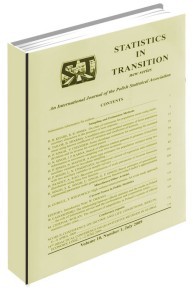A Bayesian Small Area Model with Dirichlet Processes on the Responses
A Bayesian Small Area Model with Dirichlet Processes on the Responses
Author(s): Jiani Yin, Balgobin NandramSubject(s): Business Economy / Management
Published by: Główny Urząd Statystyczny
Keywords: Bayesian computation; bootstrap; predictive inference; robust modeling; computational and model diagnostics; survey data
Summary/Abstract: Typically survey data have responses with gaps, outliers and ties, and the distributions of the responses might be skewed. Usually, in small area estimation, predictive inference is done using a two-stage Bayesian model with normality at both levels (responses and area means). This is the Scott-Smith (S-S) model and it may not be robust against these features. Another model that can be used to provide a more robust structure is the two-stage Dirichlet process mixture (DPM) model, which has independent normal distributions on the responses and a single Dirichlet process on the area means. However, this model does not accommodate gaps, outliers and ties in the survey data directly. Because this DPM model has a normal distribution on the responses, it is unlikely to be realized in practice, and this is the problem we tackle in this paper. Therefore, we propose a two-stage non-parametric Bayesian model with several independent Dirichlet processes at the first stage that represents the data, thereby accommodating some of the difficulties with survey data and permitting a more robust predictive inference. This model has a Gaussian (normal) distribution on the area means, and so we call it the DPG model. Therefore, the DPM model and the DPG model are essentially the opposite of each other and they are both different from the S-S model. Among the three models, the DPG model gives us the best head-start to accommodate the features of the survey data. For Bayesian predictive inference, we need to integrate two data sets, one with the responses and other with area sizes. An application on body mass index, which is integrated with census data, and a simulation study are used to compare the three models (S-S, DPM, DPG); we show that the DPG model might be preferred.
Journal: Statistics in Transition. New Series
- Issue Year: 21/2020
- Issue No: 3
- Page Range: 1-19
- Page Count: 19
- Language: English

